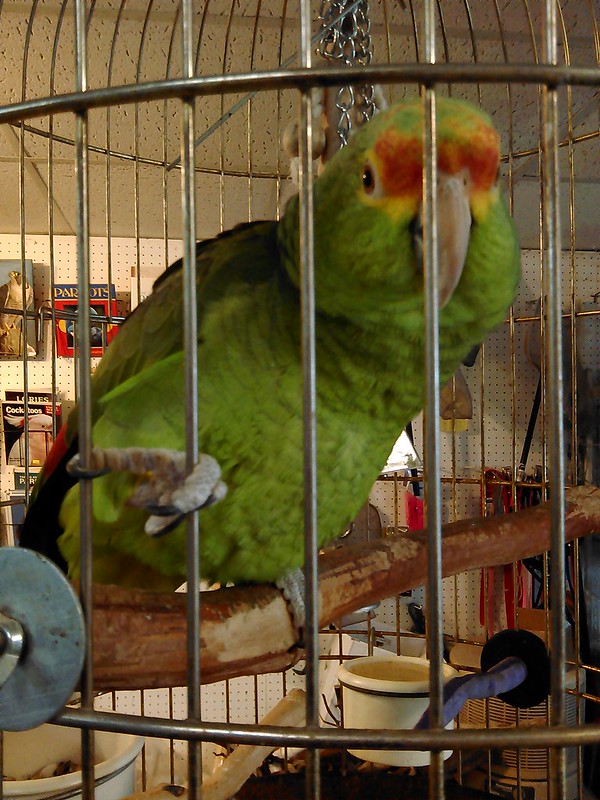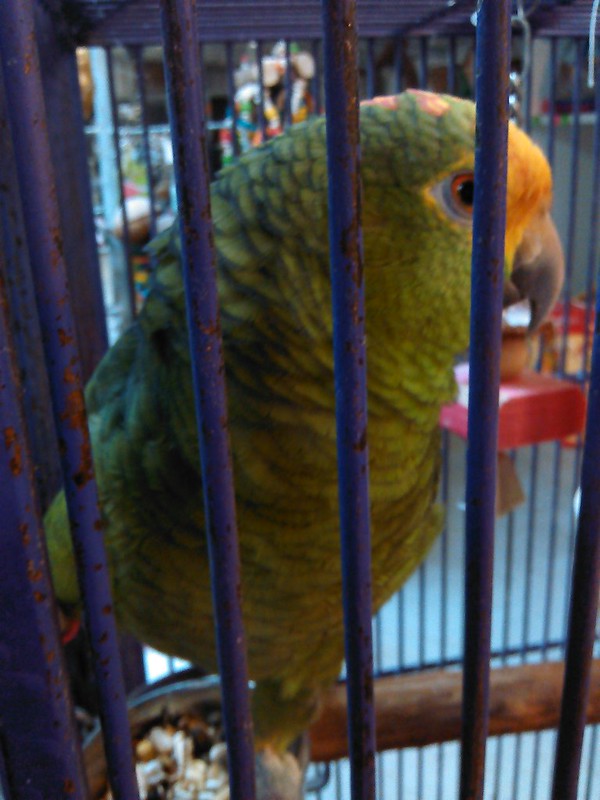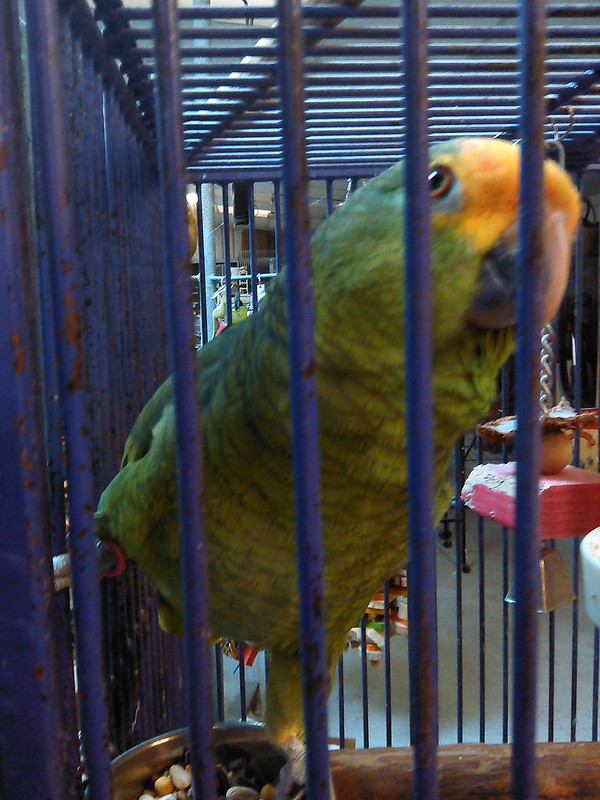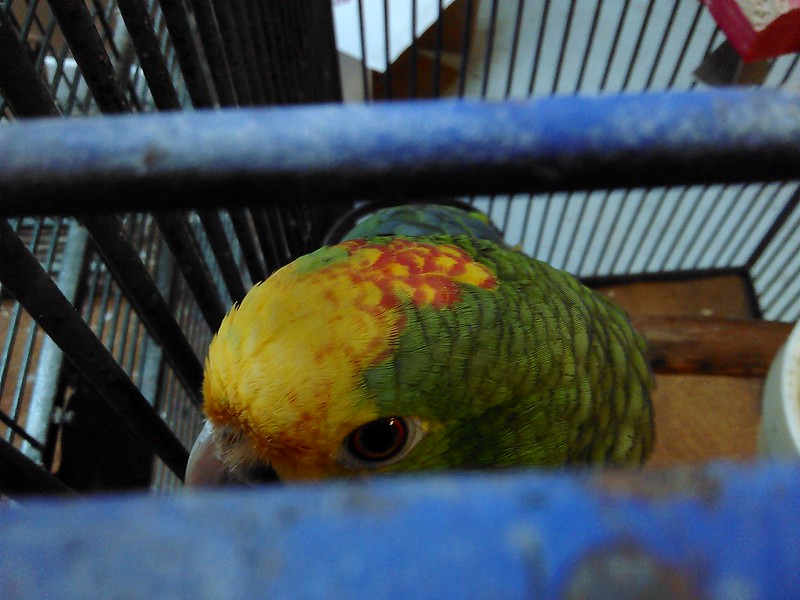Navigation
Install the app
How to install the app on iOS
Follow along with the video below to see how to install our site as a web app on your home screen.
Note: This feature may not be available in some browsers.
More options
Style variation
You are using an out of date browser. It may not display this or other websites correctly.
You should upgrade or use an alternative browser.
You should upgrade or use an alternative browser.
yellow crowned amazon x blue fronted amazon Hybrids????
- Thread starter Merrs
- Start date
JerseyWendy
New member
- Jul 20, 2012
- 20,995
- 29
Yes, it's absolutely possible.
http://www.parrotforums.com/amazons/30452-possible-have-hybrid-amazons.html
http://www.parrotforums.com/amazons/30452-possible-have-hybrid-amazons.html
I understand the interest and yes it can happen in a natural settings.
However, and IMHO, I do not believe in cross-breeding. Things are just as likely to go wrong and with Murthy's Law always lurking in the background more commonly greater than 50/50%. Point being, with the very wide cross-section of Amazons in the world today, I see no reason for cross-breeding.
Please understand that resulting from the loss of natural breeding areas across Central and South America. North America is quickly becoming the only place many Amazons are still available. In addition, transporting some Amazons (and MAC's) in North America is being hindered by Laws designed to protect them.
Please do not Cross-Breed New World Parrots. We need ever pure breed we have.
However, and IMHO, I do not believe in cross-breeding. Things are just as likely to go wrong and with Murthy's Law always lurking in the background more commonly greater than 50/50%. Point being, with the very wide cross-section of Amazons in the world today, I see no reason for cross-breeding.
Please understand that resulting from the loss of natural breeding areas across Central and South America. North America is quickly becoming the only place many Amazons are still available. In addition, transporting some Amazons (and MAC's) in North America is being hindered by Laws designed to protect them.
Please do not Cross-Breed New World Parrots. We need ever pure breed we have.
- Nov 6, 2013
- 48,579
- 41,891
- Parrots
- Hawkhead(Darwin),YCA(Dexter),VE (Ekko),OWA(Slater),BHP(Talli),DYH(Calypso),RLA(Kimera),Alex(Xander)CBC(Phoe),IRN (Kodee,Luna,Stevie),WCP (Pisces),CAG(Justice)GCC (Jax), GSC2(Charley)
Great pictures, Monica! I love the pattern on the head of the last one.
OK, great colours on these two non-mature Amazons. So, yup, someone cross-bred these two 'separately' spectacular Amazons and hence these two Hybrids.
So, was the process designed to provide a healthier Amazon or just for kicks we have this Hybrid, or even worst, the Amazons were allowed to just cross-bred with no consideration one way or the other. Please understand that I do not mean to be hardhearted, but the nagging question is WHY!
Before I step in it! What are the current age of these two guys? I see we still have some dark colour to the beaks and that the red is filtering in on the head, but yellow is not yet on the necks or fully on the head. With both Amazons being the same age, there is a clear differences in the amount of yellow on the heads. That would imply that they are much less than four /five years of age.
Sorry, I just cannot get excited about this. There are true differences between these two spectacular Amazons Species. Neither of these species have specific weaknesses that would be off-set by crossing them.
Prays that they gain to the positive side of this mix. It is my hope that they will be followed and records taken as to the outcome of this mix.
So, was the process designed to provide a healthier Amazon or just for kicks we have this Hybrid, or even worst, the Amazons were allowed to just cross-bred with no consideration one way or the other. Please understand that I do not mean to be hardhearted, but the nagging question is WHY!
Before I step in it! What are the current age of these two guys? I see we still have some dark colour to the beaks and that the red is filtering in on the head, but yellow is not yet on the necks or fully on the head. With both Amazons being the same age, there is a clear differences in the amount of yellow on the heads. That would imply that they are much less than four /five years of age.
Sorry, I just cannot get excited about this. There are true differences between these two spectacular Amazons Species. Neither of these species have specific weaknesses that would be off-set by crossing them.
Prays that they gain to the positive side of this mix. It is my hope that they will be followed and records taken as to the outcome of this mix.
MonicaMc
Well-known member
- Sep 12, 2012
- 7,960
- 44
- Parrots
- Mitred Conure - Charlie 1994;
Cockatiel - Casey 2001;
Wild Caught ARN - Sylphie 2013
Great pictures, Monica! I love the pattern on the head of the last one.
Indeed! Her's were stunning! There were only two birds, clutch mates. Male, golden cage. Female, blue cage. Interesting to see how their colorations differ.
OK, great colours on these two non-mature Amazons. So, yup, someone cross-bred these two 'separately' spectacular Amazons and hence these two Hybrids.
So, was the process designed to provide a healthier Amazon or just for kicks we have this Hybrid, or even worst, the Amazons were allowed to just cross-bred with no consideration one way or the other. Please understand that I do not mean to be hardhearted, but the nagging question is WHY!
Before I step in it! What are the current age of these two guys? I see we still have some dark colour to the beaks and that the red is filtering in on the head, but yellow is not yet on the necks or fully on the head. With both Amazons being the same age, there is a clear differences in the amount of yellow on the heads. That would imply that they are much less than four /five years of age.
Sorry, I just cannot get excited about this. There are true differences between these two spectacular Amazons Species. Neither of these species have specific weaknesses that would be off-set by crossing them.
Prays that they gain to the positive side of this mix. It is my hope that they will be followed and records taken as to the outcome of this mix.
Unfortunately, many hybrids occur due to ignorance or by accident. Yes, there are plenty of people who do it intentionally, but I can think of several incidents where it wasn't planned, and with no prior knowledge of it occurring, people didn't think it was possible and it happened anyway....
Here is a picture of a blue front x orange wing hybrid. The breeder/owner thought both birds were blue fronts and allowed them to breed....
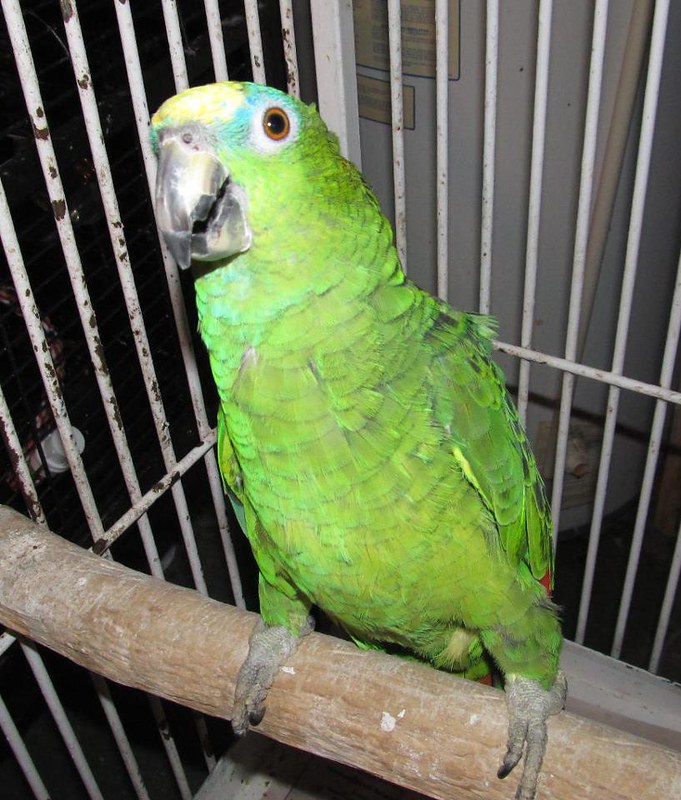
Sadly, it's not uncommon to see.... I've seen cherry head x mitred conure pairs being sold as cherry heads, including the hybrid offspring, or there are the people who think that cherry heads and mitreds are the same species. And then there are the poor waglers that are being called cherry heads or mitreds....
I've seen sun x jenday pairs where the person thought the birds were both suns. The stupidity here got pretty bad by one person! They said you could tell the sexes apart due to wing coloration. Or the sun x sunday pairs that are supposedly pure suns. Then we have the gold caps that we don't know what they are, either!
And I've seen people stick lovebirds together and create hybrids. It's a lovebird, coloration doesn't matter. Same species, right? In their mind, it's like different colors of a labrador retriever.... The offspring are still going to be lovebirds...
Or we have the mixed flock settings..... the origional galatiel was from having a male galah in with a flock of cockatiels. The plan wasn't to create a hybrid, just keeping all the birds in an aviary and breeding the cockatiels.
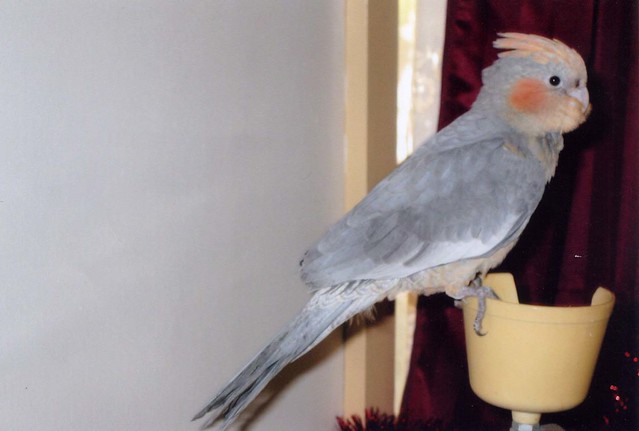
Other crosses like this include a blue fronted amazon and a mitred conure (if the photo still exists, it would be on this website), possibly a rainbow lorikeet x king parrot, and kakariki x rosella hybrids, too. There are other mixed species, too, but I don't know if this is the result of mixed aviaries or not.
And there are the many Pyrrhura x Large Conure hybrids, too... mostly Green Cheek x Sun Conure. Different species of conures from different genera. So many people didn't think it was possible, many vets said it wasn't possible, so there shouldn't be any harm in allowing the two most popular conure species to mate and lay eggs because the eggs wouldn't be fertile. Well, they were. More and more people are learning about these hybrids in an unintended way, and sadly, these hybrids do have some health issues. *MOST* hybrids are born healthy, but these guys it's a crap-shoot. The chicks may be born perfectly healthy, or they might be born with foot deformities. I've heard that they have high chick mortality rates and heard of one that died at 6 months of age due to cancer.
https://www.flickr.com/search/?w=1329724@N20&m=pool&q=green cheek
I don't personally own any hybrids, nor have I ever owned a hybrid. I do believe that these two amazons though (the DYH x RLA) are adults from an unplanned mating. I don't remember how old they are, but I do believe they were born in Florida, then the owner moved to California and had to give her birds up. In the pictures, they are sitting in a "pet store". The photos were taken nearly 4 months ago.
I do believe that the beak coloration will probably remain the way it is, since RLA's have darker beaks than DYH's, and the majority of crosses between black beak x horn beak typically results in 75% to 100% black beak offspring. Not always true, especially when going into multi-gen hybrids. Granted, there are some red/green conures (mitred/cherry head) mixed with "yellow" conures (suns?) that got the horn colored beaks, with only a smidge of dark coloration. Maybe like 15% or less of the beak is dark.
As for coloration of the feathers? I don't know. I don't remember how old these two were, other than adults, so it may very well change, or it could remain the same.
I don't know if the two are still for sale at the "store", or if someone has already bought them.
The newest cross I've seen is a Jardines x Timneh.... now that is one interesting hybrid! And I do think this one was planned? If I understood it right though, they aren't planning on any more of these hybrids... but I could be wrong. Second hand info here....
Last edited:
Kiwibird
Well-known member
- Jul 12, 2012
- 9,539
- 114
- Parrots
- 1 BFA- Kiwi. Hatch circa 98', forever home with us Dec. 08'
OMG! The fact a galatiel exists truly shocks me. The size difference would seem like it would prevent natural interbreeding without human intervention. I think I've had enough learning for today after that!
Thanks for the information though Monica, well researched and well written as always.
Thanks for the information though Monica, well researched and well written as always.
MonicaMc
Well-known member
- Sep 12, 2012
- 7,960
- 44
- Parrots
- Mitred Conure - Charlie 1994;
Cockatiel - Casey 2001;
Wild Caught ARN - Sylphie 2013
OMG! The fact a galatiel exists truly shocks me. The size difference would seem like it would prevent natural interbreeding without human intervention. I think I've had enough learning for today after that!
Thanks for the information though Monica, well researched and well written as always.
Interesting fact!
Unlike in dogs where it's the male that *mainly* determines the size of the pups, in parrots, it's the female that determines the size of the eggs!
First mating Male Galah x Female Pied Cockatiel.
Here's another photo of the same bird.
https://www.flickr.com/photos/mfids/2990743896/in/photolist-5ycYbv-5yhkXW
More info and video can be found here!
World first, galah breeds with cockatiel ? Talking Birds
Since this original accident, there have been at least one or two other breeders who have decided to also create galatiels. There's been at least two or three other photos floating around the internet from the different breeder(s). Here's one of them.

With the help of others, I've been gathering photos of various hybrids. Really helps to learn how closely related some of these birds really are.
https://www.flickr.com/groups/hybrid_parrots/
msdeb
Member
- Dec 22, 2013
- 153
- 5
- Parrots
- Charlie the birdie, yellow naped amazon and little bird, a monk parrot , and Polly -yellow crowned amazon
I understand the interest and yes it can happen in a natural settings.
However, and IMHO, I do not believe in cross-breeding. Things are just as likely to go wrong and with Murthy's Law always lurking in the background more commonly greater than 50/50%. Point being, with the very wide cross-section of Amazons in the world today, I see no reason for cross-breeding.
Please understand that resulting from the loss of natural breeding areas across Central and South America. North America is quickly becoming the only place many Amazons are still available. In addition, transporting some Amazons (and MAC's) in North America is being hindered by Laws designed to protect them.
Please do not Cross-Breed New World Parrots. We need ever pure breed we have.
Paulie is a hybid. Her mother was a double yellow headed and her father ?? I don't have a lot of info about him. The owner just let her two Amazons breed casually, not as a breeder. Paulie has interesting coloring about her head, I see a little patch of blue and her shoulder patches are not red but orange. Her yellow is only on the top of her head and her beak is a lighter gray. Of course there are variations even within species. She is also significantly smaller than Charlie, but Charlie is a big bird even for a yellow naped, I believe. Paulie has a much calmer nature than Charlie but is that age or species temperament? Whatever species she is I am glad to have her because she is a lovebug! I do agree that genetics should be carefully considered before breeding, designer pets can carry genetic faults that are risky to the animals themselves as well as an owner who may lose their heart to a pet only to lose them to a unforeseen genetic risk.
Allee
Well-known member
- Oct 27, 2013
- 16,852
- 228
- Parrots
- U2-Poppy(Poppy lives with her new mommy, Misty now) CAG-Jack, YNA, Bingo, Budgie-Piper, Cockatiel-Sweet Pea Quakers-Harry, Sammy, Wilson ***Zeke (quaker) Twinkle (budgie) forever in our hearts
Thank you for the wonderful photos and well researched information, Monica! Interesting topic.
msdeb
Member
- Dec 22, 2013
- 153
- 5
- Parrots
- Charlie the birdie, yellow naped amazon and little bird, a monk parrot , and Polly -yellow crowned amazon
View attachment 17067
I believe that pic is the orange on his wing. The colors on his flight wings is pure red. The blue around the eyes is very subtle but definitely present (harder to get pix without getting my phone bit!). I just think he is beautiful
I believe that pic is the orange on his wing. The colors on his flight wings is pure red. The blue around the eyes is very subtle but definitely present (harder to get pix without getting my phone bit!). I just think he is beautiful
Last edited:
MonicaMc
Well-known member
- Sep 12, 2012
- 7,960
- 44
- Parrots
- Mitred Conure - Charlie 1994;
Cockatiel - Casey 2001;
Wild Caught ARN - Sylphie 2013
I do agree that genetics should be carefully considered before breeding, designer pets can carry genetic faults that are risky to the animals themselves as well as an owner who may lose their heart to a pet only to lose them to a unforeseen genetic risk.
Well, by definition, I wouldn't consider hybrids to be "designer pets"... at least not in the same way as dog mutts are considered "designer pets". For that, we have the English Budgerigar!
I would say though that *most* hybrid parrots are probably rather healthy individuals. You only really see health issues in hybrids from parents that are not closely related, and some multi-species, multi-gen hybrid macaws. Otherwise, hybrids may be just as healthy, if not healthier, than any other parrot out there!
There's evidence that green cheek conures and maroon bellied conures have naturally hybridized in the wild since they share a genetic trait.
The crimson rosella hybridizes with the yellow rosella, resulting in the hybrid swam known as the adelaide rosellas.
And now we have a hybrid swarm of lorikeets in Australia being made up of 2 to 3 species.
There are hybrid animals around the world, some rare but occurring naturally (i.e. polar bear x grizzly), some that created an entirely new species (the red wolf of North America - grey wolf x coyote).
So being of hybrid origin isn't an "end all" for most hybrids out there, and sadly, with the way that the laws in the USA are heading towards, the only birds we'll be able to own may end up being hybrids. Protected species can't cross state lines unless it's for breeding, which is stupid when the birds wont be used to repopulate the wild population - but hybrids don't have any restrictions.
chris-md
Well-known member
- Feb 6, 2010
- 4,384
- 2,190
- Parrots
- Parker - male Eclectus
Aphrodite - red throated conure (RIP)
You're very right Monica and that's generally my take on it. Hybrid vigor is absolutely a real thing, and hybrids in the wild are not at all rare.
To be clear, genetic incompatibility occur with too distantly related animals (creating mortality issues in babies and sterility issues in surviving adults; ligers, mules, etc) and CLOSELY related animals (incest). Incestuous breeding to bring out unique (recessive) traits is the reason dogs have so many genetic issues. And they are all the same species, from the tea cup Yorkie to the Great Dane.
If your hybrid bird survives as a hatchling, the odds of losing it to a genetic defect are about the same as a pure species. Minimal to say the least.
To be clear, genetic incompatibility occur with too distantly related animals (creating mortality issues in babies and sterility issues in surviving adults; ligers, mules, etc) and CLOSELY related animals (incest). Incestuous breeding to bring out unique (recessive) traits is the reason dogs have so many genetic issues. And they are all the same species, from the tea cup Yorkie to the Great Dane.
If your hybrid bird survives as a hatchling, the odds of losing it to a genetic defect are about the same as a pure species. Minimal to say the least.
Boozieshome
New member
- May 26, 2017
- 97
- 0
- Parrots
- Bonnie and Clyde, Umbrella 'Toos, and BoozieToo, a double yellow Amazon. RIP Boozie, Blue crowned mealy Amazon
Thank you for this thoughtful response. I read some of the other replies and thought to myself that these were not rational or zoological responses. Speciation has not occurred if two birds can mate and produce viable offspring. The birds that we are calling species are not actually species, and their genetic variation is only enhanced by expanding the gene pool. If they do it on their own, what is the problem? Let the birds choose their mates, and if they are happy, why would we be so holier than thou?
Thank you for this thoughtful response. I read some of the other replies and thought to myself that these were not rational or zoological responses. Speciation has not occurred if two birds can mate and produce viable offspring. The birds that we are calling species are not actually species, and their genetic variation is only enhanced by expanding the gene pool. If they do it on their own, what is the problem? Let the birds choose their mates, and if they are happy, why would we be so holier than thou?
Not sure if you are Fanning a Flame or just adding to a Thread that had long ago ran its course.
With Amazons, there are approximately 38 Species with an additional 20 that are Range Specific Hybrids, shaped by the demands of their Range and/or limited exposure to other like Species.
I am not going to get into the 'Why Not's,' as I see that as only fanning a flame game. Today, the combination of far fewer Breeders and the smaller Bird Trade Market, plus the loss of their Natural Ranges, Amazons, as a family will be reclassified as CITIES I for the majority of them and CITIES II for those few that are not yet classified as endangered. In simpler terms, what clarity of species exists in the captive population is becoming ever more important to the overall Species every year.
As I stated, this Thread had long ago ran its course.
Most Reactions
-
 309
309 -
 242
242 -
 115
115 -
 112
112 -
 103
103 -
 77
77 -
 75
75 -
 58
58 -
 44
44 -
J
41
-
 41
41 -
 32
32 -
 29
29 -
 27
27 -
 19
19
Similar threads
- Replies
- 10
- Views
- 963

